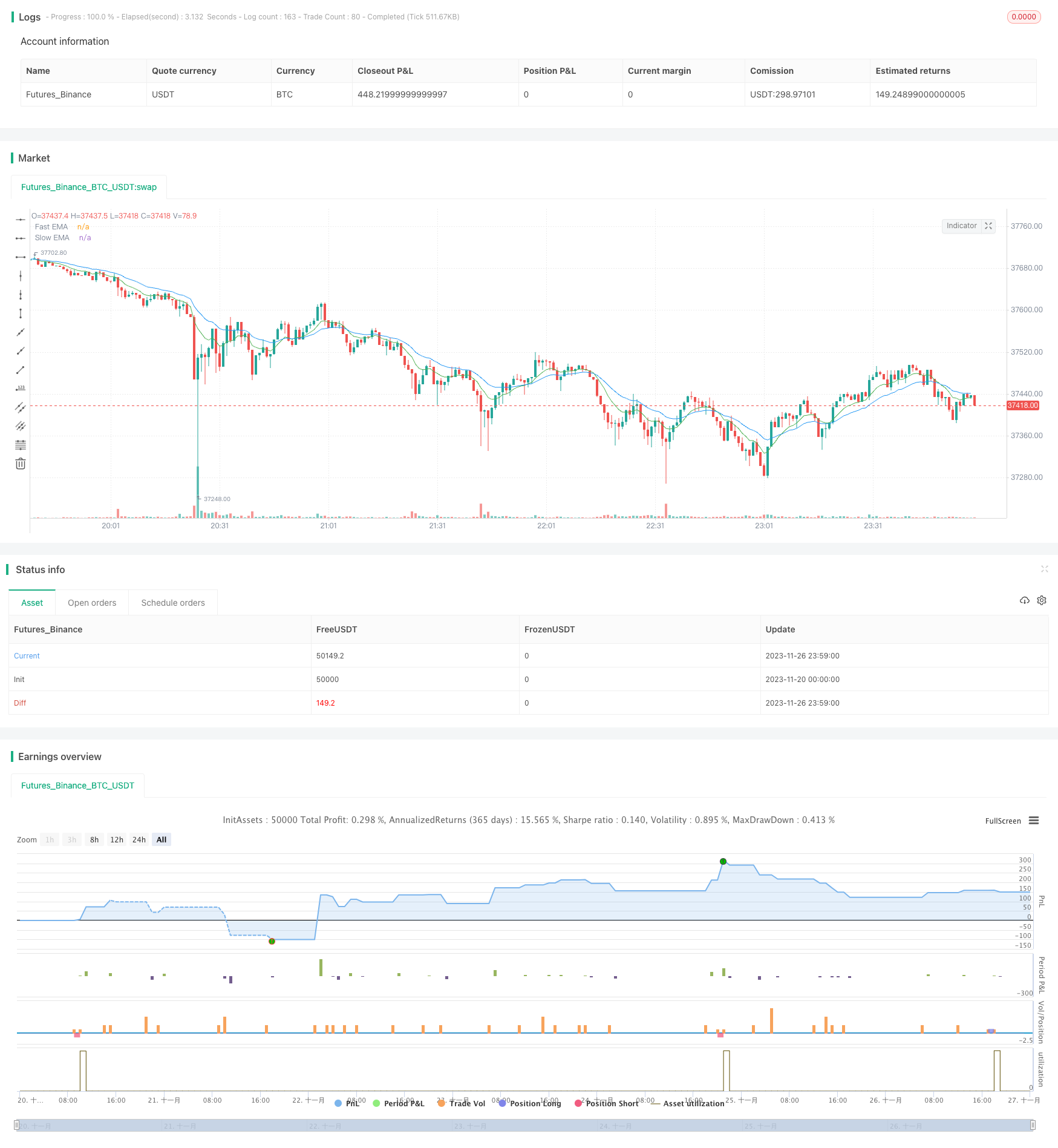
概述
双EMA黄金交叉突破策略通过计算快线EMA和慢线EMA的交叉情况,结合交易量突破、K线形态以及价格突破判断来产生买入和卖出信号。该策略综合多种技术指标,旨在提高信号的可靠性,在捕捉价格趋势的同时控制风险。
策略原理
双EMA黄金交叉突破策略的核心逻辑基于双EMA的黄金交叉理论。该理论认为,当短期EMA上穿较长期EMA时,代表价格上涨势头较强,应该建立多头仓位;当短期EMA下穿较长期EMA时,代表价格下跌势头较强,应该建立空头仓位。
具体来说,该策略首先计算9日EMA和21日EMA。当9日EMA上穿21日EMA时,产生“长”信号;当9EMA下穿21EMA时,产生“短”信号。为了过滤假信号,策略还设置了以下判断条件:
交易量条件。最近K线的交易量需要大于前5根K线的平均交易量的85%。这个条件可以过滤出交易量不足的假信号。
价格突破条件。价格需要突破9日EMA,作为进场确认。
K线形态条件。需要识别出反转K线形态,包括向上吞没形态或向下吞没形态。这可以避免在盘整震荡时重复进出场。
在多头仓位中,当价格跌破9日EMA时,执行平仓退出。在空头仓位中,当价格涨破9日EMA时,同样执行平仓退出。
优势分析
双EMA黄金交叉突破策略结合多种技术指标信号,可以有效识别价格趋势,提高交易胜率。其主要优势有:
使用双EMA判断主要趋势方向,可靠性较高。
增加交易量过滤,避免在交易量不足时发出错误信号。
增加K线形态判断,可以过滤震荡盘整市场的噪音。
价格突破EMA时进场,可以确认趋势。
设定止损退出机制,可以主动控制风险。
风险分析
双EMA黄金交叉突破策略也存在一定的风险,主要集中在以下几个方面:
在震荡行情中,EMA可能发出错误信号,从而导致交易亏损。可以通过整体趋势判断来决定是否开仓。
固定的EMA周期设置可能无法适应市场的变化,可以尝试采用自适应EMA。
反转K线形态判断依然存在一定误判概率,停损机制可以用来控制风险。
策略可能会错过部分行情,无法完美追踪价格。可以适当调整参数,或与其他策略组合使用。
优化方向
双EMA黄金交叉突破策略还有以下几点主要优化方向:
测试更多的EMA组合,寻找最佳参数。
增加自适应EMA,根据市场变化调整EMA参数。
优化仓位管理,不同行情采用不同的仓位。
结合更多指标进行优化,如MACD、KDJ等,形成策略组合。
引入机器学习等高级技术进行模型融合,提高策略稳定性。
总结
双EMA黄金交叉突破策略通过双EMA判断趋势方向,并增加交易量/价格/K线形态多重过滤,可以有效识别趋势,在控制风险的同时提高交易效率。该策略操作简单,容易实施,同时还留有很多优化空间,是一种值得推荐的突破交易策略。
/*backtest
start: 2023-11-20 00:00:00
end: 2023-11-27 00:00:00
period: 1m
basePeriod: 1m
exchanges: [{"eid":"Futures_Binance","currency":"BTC_USDT"}]
*/
//@version=5
//Author: Andrew Shubitowski
strategy("Buy/Sell Strat", overlay = true)
//Define EMAs & Crossovers (Feature 2)
a = ta.ema(close, 9)
b = ta.ema(close, 21)
crossUp = ta.crossover(a, b)
crossDown = ta.crossunder(a, b)
//Define & calc volume averages (Feature 1)
float volAvg = 0
for i = 1 to 5
volAvg := volAvg + volume[i]
volAvg := volAvg / 5
//Define candlestick pattern recongition (Feature 4)
bool reversalPatternUp = false
bool reversalPatternDown = false
if (close > close[1] and close[1] > close [2] and close[3] > close[2] and close > close[3])
reversalPatternUp := true
if (close < close[1] and close[1] < close [2] and close[3] < close[2] and close < close[3])
reversalPatternDown := true
//Execute trade (Feature 3 + 5)
if (crossUp)
strategy.entry("long", strategy.long, when = ((volume * 0.85) > volAvg and close > a and reversalPatternUp == true))
if (crossDown)
strategy.entry("short", strategy.short, when = ((volume * 0.85) > volAvg and close < a and reversalPatternDown == true))
//Exit strategy (New Feature)
close_condition_long = close < a
close_condition_short = close > a
if (close_condition_long)
strategy.close("long")
if (close_condition_short)
strategy.close("short")
//plot the EMAs
plot(a, title = "Fast EMA", color = color.green)
plot(b, title = "Slow EMA", color = color.blue)
//Some visual validation parameters
//plotchar(volAvg, "Volume", "", location.top, color.aqua) //*TEST* volume calc check
//plotshape(reversalPatternUp, style = shape.arrowup, color = color.aqua) //*TEST* reversal check
//plotshape(reversalPatternDown, style = shape.arrowup, location = location.belowbar, color = color.red) //*TEST* reversal check